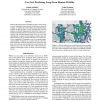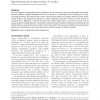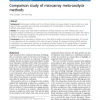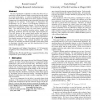282 search results - page 9 / 57 » Comparison of Different Methods for Next Location Prediction |
ISMB
2000
13 years 10 months ago
2000
Determination of the functions of all expressed proteins represents one of the major upcoming challenges in computational molecular biology. Since subcellular location plays a cru...
AAAI
2012
11 years 11 months ago
2012
Much work has been done on predicting where is one going to be in the immediate future, typically within the next hour. By contrast, we address the open problem of predicting huma...
BIB
2008
13 years 9 months ago
2008
For most organisms, computational operon predictions are the only source of genome-wide operon information. Operon prediction methods described in literature are based on (a combi...
BMCBI
2010
13 years 9 months ago
2010
Background: Meta-analysis methods exist for combining multiple microarray datasets. However, there are a wide range of issues associated with microarray meta-analysis and a limite...
SIGGRAPH
1995
ACM
14 years 10 days ago
1995
ACM
The use of prediction to eliminate or reduce the effects of system delays in Head-Mounted Display systems has been the subject of several recent papers. A variety of methods have ...




